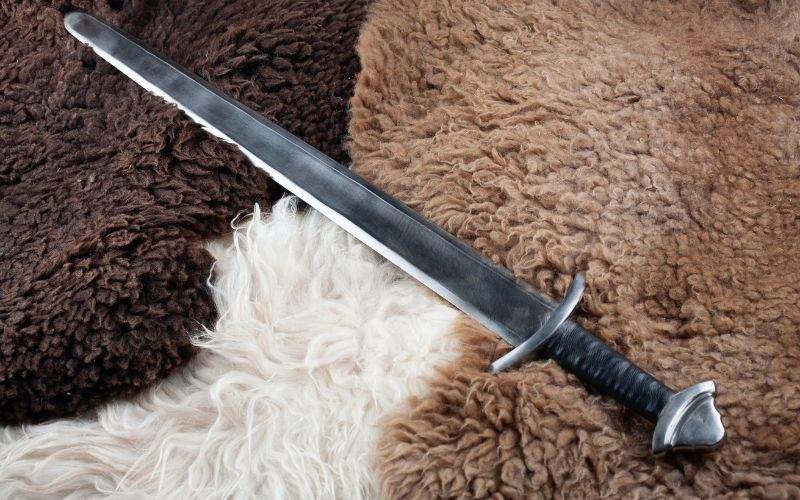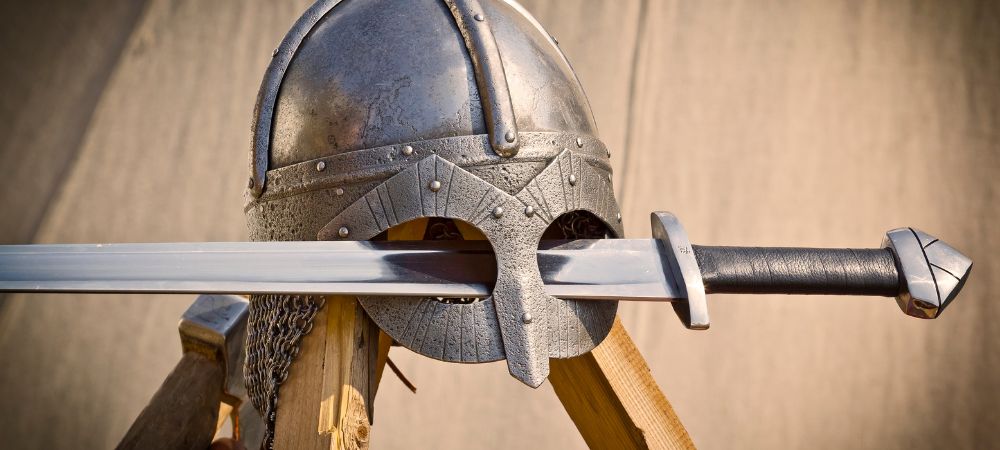Viking Swords
Scandinavian Vendel era sword in Damascus steel, silver finish
Scandinavian sword Vendel era in Damascus steel, brass finish
Viking sword Eigg island, bronze hilt and Damascus steel blade
Viking sword, Petersen type, for practice - Short version (80.5 cm.)
Viking sword, Petersen type, for practices - Long version (90.5 cm.)
Viking sword, Petersen H type, for practice - Short version (81.5 cm.)
Viking sword, Petersen H type, for practice - Long version (91.5 cm.)
The History and Symbolism of Viking Swords
Viking swords are more than just simple weapons; they are symbols of a rich and fascinating culture. During the Viking era, these swords represented not only valor in battle but also the craftsmanship of the blacksmiths who made them. Each sword had a story, often related to the warriors who wielded them, and it was common for them to be passed down from generation to generation.
The majority of Viking swords were forged from steel and often featured inscriptions on their blades, narrating feats or invoking the protection of the gods. These inscriptions and decorations were not only aesthetically pleasing but also fulfilled a spiritual and ceremonial sentiment, making them sacred elements for Viking warriors.
The Evolution of Viking Swords Through the Centuries
From the early days of the Vikings to the end of their dominance, swords underwent significant evolution. The swords from the earliest Viking era were characterized by their broad blades and sharp tips, ideal for close combat. Over time, styles and forging techniques changed, leading to more refined and lighter variants that increased the warrior's speed on the battlefield.
As technology in metallurgy advanced, swords became increasingly sophisticated and decorated, reflecting the social status of their bearers. This led to the creation of swords from the period spanning the 9th to the 11th centuries, where improvements in functionality could be observed alongside rich ornamentation that became a symbol of power and nobility in Viking society.
The Manufacturing Process of Viking Swords
The crafting of Viking swords is an art that involves both technique and passion. Blacksmiths of the time used traditional forging methods, which consisted of heating the metal and hammering it repeatedly until the desired shape was achieved. This process required not only skill but also extensive knowledge about different types of metals and their properties.
Viking blacksmiths were considered true master craftsmen and often specialized in creating custom swords for prominent warriors. These swords were made according to the preferences of the bearer, being decorated with special grips and unique designs that reflected their personality and power.
Use and Practice of Swords in Viking Culture
The use of swords in Viking culture went beyond simple combat. They were tools of status and rituals, used in ceremonies such as marriages and offerings to the gods. The sword was a loyal companion and was seen as a symbol of honor, so its bearer had to be worthy of carrying it.
Viking warriors trained intensively in the handling of their swords, practicing different forms of combat. Viking fighting techniques included both the use of the sword and other weapons like axes and spears. This comprehensive approach ensured that each warrior was prepared for any confrontation on the battlefield, keeping the Viking warrior tradition alive.
Viking Swords in Modern Art and Culture
Today, Viking swords have left a profound mark on modern art and popular culture. From movies and television series to video games, Viking swords are appreciated as symbols of daring and bravery. This representation has revitalized interest in Viking history and its emblematic weapons.
Collectors and enthusiasts alike seek authentic pieces that capture the essence of this rich culture. The demand for functional and decorative replicas has grown, allowing new generations to appreciate the craftsmanship and history behind these magnificent weapons, as well as their relevance in contemporary cultural identity.
What materials are used in the manufacturing of Viking swords?
Viking swords were primarily made of steel, although some models also incorporated components of bronze and other metals. The steel was also treated in various ways, such as the use of Damascus, which combines different layers of metal to create a stronger and more aesthetically pleasing blade. This process not only guarantees functionality but also the beauty of the sword.
Are Viking swords suitable for combat today?Yes, many modern Viking swords are specifically designed for combat and are functional. However, it is essential to check the specifications and ensure they are made with high-quality materials. Some models, additionally, are intended for specific practices, such as Buhurt-HMB, ensuring their durability and resistance.
What is the difference between decorative and functional Viking swords?Decorative swords are primarily designed for display and may not be made for real combat. Their focus is on aesthetics, often featuring elaborate details and fine finishes. In contrast, functional swords are built to withstand use in combat and training, which involves a focus on resilience and durability, while also considering design.
How to properly care for a Viking sword?To keep a Viking sword in perfect condition, it is important to clean it after each use, using a soft cloth to remove moisture and dust. It is also recommended to apply specialized oil to protect the steel from oxidation. Proper storage is crucial as well, using covers or cases designed to keep the sword safe and away from adverse conditions.
Can Viking swords be used in historical reenactments?Viking swords are very popular in historical reenactments, and many enthusiasts opt for functional swords or replicas that are specifically designed for this purpose. However, it is vital to ensure that the chosen swords comply with safety regulations and rules of the activity in which one will participate, thus ensuring the ability to enjoy the event safely.
What kind of training is needed to use a Viking sword?Using a Viking sword safely and effectively requires proper training. This includes learning handling techniques, combat, and specific strategies for sword use. Many historical martial arts academies offer classes on Viking fencing, where both theory and practice are taught to master the use of this type of weaponry.
Do Viking swords have any connection to mythology?Viking swords are deeply rooted in Norse mythology. Many swords were considered sacred and bearers of power, often glorified in the sagas and tales of heroes. Each sword sometimes bore a name and was seen as a talisman, protecting its bearer in battle with the help of deities like Odin and Thor.
Discover the fascinating world of Viking swords in our online store. With a variety of models and styles for all enthusiasts, you can find the sword that will become your companion on your adventure. Visit us and get a piece of history that you can hold in your hands!
















































































































































































































































































